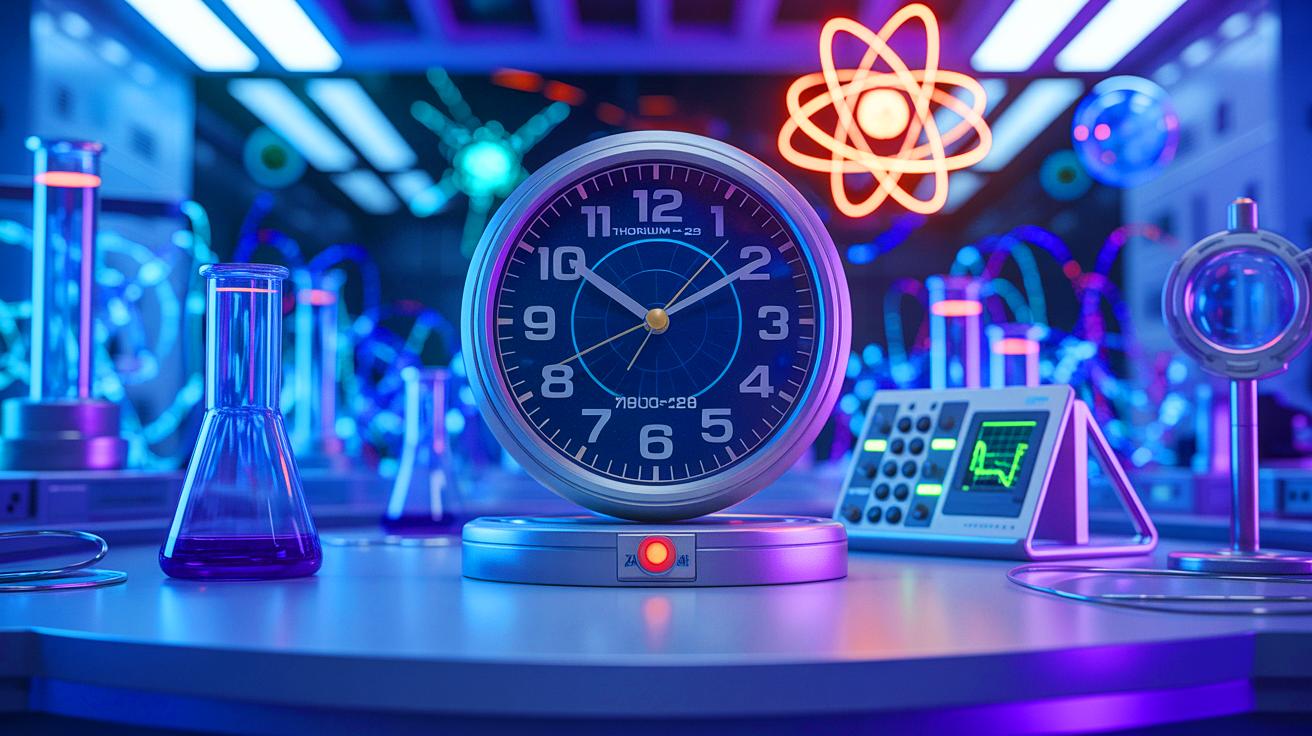- 🌌 Scientists have developed a groundbreaking thorium-229 nuclear clock to enhance the detection of elusive dark matter.
- 🔬 The nuclear clock’s precision allows researchers to study the subtle effects of dark matter on atomic structures using the resonance frequency of thorium-229.
- 🔍 New methods enable the observation of minute shifts in thorium-229’s absorption spectrum, potentially linked to dark matter’s influence.
- ⏰ A thorium-229-based nuclear clock promises unparalleled accuracy in dark matter research and could revolutionize fields like Earth and space navigation.
In an era where the boundaries of our universe are continually expanding, scientists are making monumental strides in their quest to understand its darkest secrets. A groundbreaking study has unveiled a novel method for detecting dark matter, a mysterious substance that makes up approximately 80% of the universe’s mass. This research leverages a thorium-229 nuclear clock, a cutting-edge timekeeping device that could potentially illuminate the elusive nature of dark matter. As we delve into these new frontiers, we find ourselves on the cusp of discoveries that could redefine our understanding of the cosmos.
Unlocking the Mysteries of Dark Matter Through Precision Timekeeping
Dark matter, a cornerstone of astrophysical inquiry, has captivated scientists for decades. Yet, its direct detection remains a formidable challenge. Recent advancements suggest that a nuclear clock using thorium-229 might offer the precision needed to detect dark matter’s subtle effects. Professor Gilad Perez from the Weizmann Institute of Science asserts that while the ultimate goal of a fully functional nuclear clock is still on the horizon, significant progress has been made towards identifying new methods to study dark matter. “We still need even greater precision to develop a nuclear clock,” Perez emphasizes, “but we’ve already identified an opportunity to study dark matter.”
This development represents a significant shift from traditional dark matter detection methods, which typically rely on high-energy particle collisions or cosmic radiation. By harnessing thorium-229’s unique properties, scientists are paving the way toward unparalleled accuracy in studying dark matter, potentially transforming our approach to this enigmatic substance.
A New Window into the Universe’s Hidden Matter
Central to this groundbreaking research is the resonance frequency of thorium-229, which allows its atomic nuclei to oscillate between quantum states. This property is pivotal, as dark matter’s presence could subtly influence these oscillations. Unlike most materials, thorium-229 can be manipulated using standard laser technology due to its naturally low resonance frequency. This characteristic makes it an exceptional candidate for constructing the next generation of nuclear clocks.
The study introduces a method to detect minor shifts in thorium-229’s absorption spectrum, potentially linked to dark matter. As Perez explains, “In a universe made up only of visible matter, the physical conditions and the absorption spectrum of any material would remain constant.” However, dark matter’s pervasive influence could cause temporary shifts in these conditions, offering a novel approach to study the universe’s hidden components.
Searching for Subtle Deviations: New Approaches to Measuring Dark Matter
Detecting dark matter is akin to searching for an invisible entity that evades traditional detection methods. The thorium-229 nuclear clock presents an exciting possibility, enabling scientists to spot minute deviations in resonance frequencies indicative of dark matter. Theoretical calculations by Dr. Wolfram Ratzinger suggest that even the faintest effects of dark matter—up to 100 million times weaker than gravity—might be discernible through shifts in thorium-229’s absorption spectrum.
“This is a region where no one has yet looked for dark matter,” Ratzinger notes. His team’s groundwork aims to identify and interpret these subtle changes, promising insights into dark matter’s elusive nature. As the research progresses, there is optimism that these shifts will be pinpointed, offering a clearer understanding of this cosmic enigma.
Thorium-229 Nuclear Clock: The Ultimate Dark Matter Detector
Among the most promising outcomes of this research is the potential for thorium-229 to serve as the ultimate dark matter detector. Traditional atomic clocks, though precise, are susceptible to electrical interference, which can impede their ability to detect dark matter’s subtle forces. In contrast, a thorium-229-based nuclear clock would be less prone to such disruptions, making it an ideal tool for dark matter detection.
Perez highlights the clock’s capability to detect forces 10 trillion times weaker than gravity, with a resolution 100,000 times superior to current technologies. Beyond dark matter research, this technology holds transformative potential for fields like Earth and space navigation, power grid management, and scientific research, heralding a new era of precision timekeeping.
As we stand on the brink of these exciting developments, one cannot help but wonder: what other cosmic secrets await discovery as we refine our understanding of dark matter?
This article is based on verified sources and supported by editorial technologies.
Did you like it? 4.5/5 (30)
